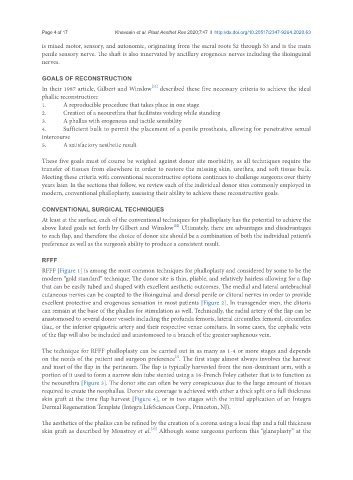Page 533 - Read Online
P. 533
Page 4 of 17 Khavanin et al. Plast Aesthet Res 2020;7:47 I http://dx.doi.org/10.20517/2347-9264.2020.63
is mixed motor, sensory, and autonomic, originating from the sacral roots S2 through S3 and is the main
penile sensory nerve. The shaft is also innervated by ancillary erogenous nerves including the ilioinguinal
nerves.
GOALS OF RECONSTRUCTION
[22]
In their 1987 article, Gilbert and Winslow described these five necessary criteria to achieve the ideal
phallic reconstruction:
1. A reproducible procedure that takes place in one stage
2. Creation of a neourethra that facilitates voiding while standing
3. A phallus with erogenous and tactile sensibility
4. Sufficient bulk to permit the placement of a penile prosthesis, allowing for penetrative sexual
intercourse
5. A satisfactory aesthetic result
These five goals must of course be weighed against donor site morbidity, as all techniques require the
transfer of tissues from elsewhere in order to restore the missing skin, urethra, and soft tissue bulk.
Meeting these criteria with conventional reconstructive options continues to challenge surgeons over thirty
years later. In the sections that follow, we review each of the individual donor sites commonly employed in
modern, conventional phalloplasty, assessing their ability to achieve these reconstructive goals.
CONVENTIONAL SURGICAL TECHNIQUES
At least at the surface, each of the conventional techniques for phalloplasty has the potential to achieve the
[22]
above listed goals set forth by Gilbert and Winslow Ultimately, there are advantages and disadvantages
to each flap, and therefore the choice of donor site should be a combination of both the individual patient’s
preference as well as the surgeon’s ability to produce a consistent result.
RFFF
RFFF [Figure 1] is among the most common techniques for phalloplasty and considered by some to be the
modern “gold standard” technique. The donor site is thin, pliable, and relatively hairless allowing for a flap
that can be easily tubed and shaped with excellent aesthetic outcomes. The medial and lateral antebrachial
cutaneous nerves can be coapted to the ilioinguinal and dorsal penile or clitoral nerves in order to provide
excellent protective and erogenous sensation in most patients [Figure 2]. In transgender men, the clitoris
can remain at the base of the phallus for stimulation as well. Technically, the radial artery of the flap can be
anastomosed to several donor vessels including the profunda femoris, lateral circumflex femoral, circumflex
iliac, or the inferior epigastric artery and their respective venae comitans. In some cases, the cephalic vein
of the flap will also be included and anastomosed to a branch of the greater saphenous vein.
The technique for RFFF phalloplasty can be carried out in as many as 1-4 or more stages and depends
on the needs of the patient and surgeon preference . The first stage almost always involves the harvest
[3]
and inset of the flap in the perineum. The flap is typically harvested from the non-dominant arm, with a
portion of it used to form a narrow skin tube stented using a 16-French Foley catheter that is to function as
the neourethra [Figure 3]. The donor site can often be very conspicuous due to the large amount of tissues
required to create the neophallus. Donor site coverage is achieved with either a thick split or a full thickness
skin graft at the time flap harvest [Figure 4], or in two stages with the initial application of an Integra
Dermal Regeneration Template (Integra LifeSciences Corp., Princeton, NJ).
The aesthetics of the phallus can be refined by the creation of a corona using a local flap and a full thickness
[23]
skin graft as described by Monstrey et al. Although some surgeons perform this “glansplasty” at the

